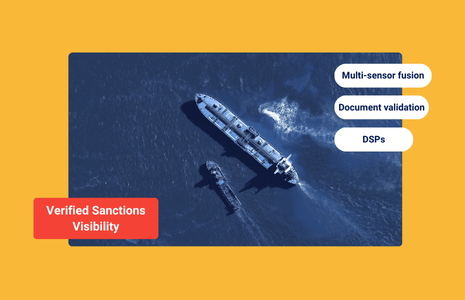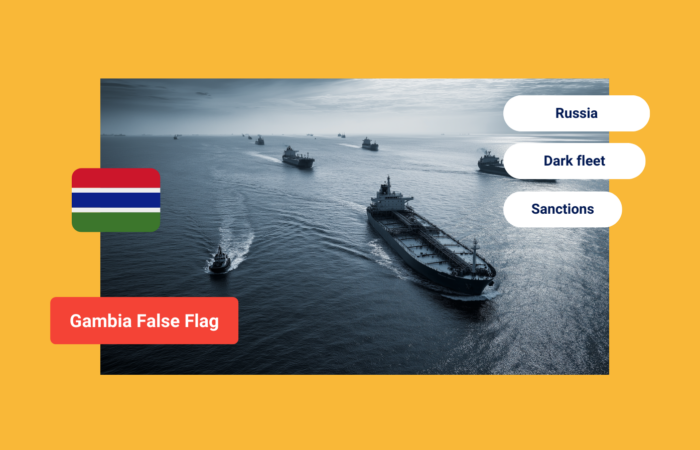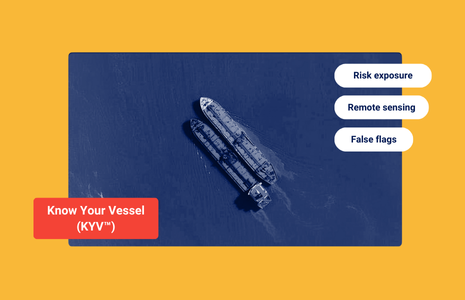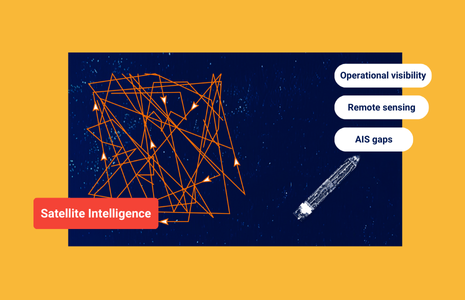Sanctioned, Stateless and Falsely Flagged Tankers Test Europe’s Resolve

What’s inside?
The dangers arising from falsely flagged, stateless and lawless ships sailing through European and UK territorial waters is something the region’s governments grapple with daily.
Sanctioned tankers using fraudulent registries such as Malawi, Eswatini and Benin are navigating the Danish Strait and English Channel every day, violating international laws and posing clear risks to maritime safety, security and the environment.
But it is highly unusual to see a falsely flagged tanker outside these lanes and in Greece territorial waters.
Yet this is exactly where Windward Maritime AI™ has identified the Aframax tanker View (IMO 9271327) anchored since July 14 near the small, uninhabited island of Agios Georgios, at the entrance to the Saronic Gulf.
False Flag Problem Now on Greek Shores
View is not only falsely flagged with Guinea but has scored the Russia sanctions trifecta: listed by EU, UK and the U.S. in the past seven months.
Windward’s MAI Expert™, a generative AI maritime agent, has summarized View’s risk scores, risk indicators, and behavioral patterns — highlighting numerous dark activities, deceptive shipping practices, extensive involvement in Russian trade, frequent changes in ownership and management, and a history of mechanical failures.
The vessel’s trajectory through the Suez Canal early in July, followed by drifting status and deviation into Greek waters for an extended period suggest that it is either detained or has mechanical issues.
Guinea is one of at least 11 countries with false flags identified by the International Maritime Organization and used by sanctioned tankers that ship Iran and Russian oil.
Fraudulent registry papers are issued by companies that falsely purport to flag the ships on behalf of the countries.
Fake registries are expanding each month as vessels are sanctioned and then expelled by countries whose flags operate legitimate open registries (sometimes called flags of convenience).
The EU and UK have each sanctioned more than 400 tankers in the past 15 months.
From Mali to Angola, New Fake Flags Multiply
Over July, two tankers re-flagged to a new, fraudulent registry of Mali, and another to Angola.
An aframax tanker and the LPG tanker Crave (IMO 9045807) are broadcasting Mali as their flag state – an African country that has no international ship registry.
Perdiot (IMO 9259991) is another U.S.-sanctioned product tanker falsely broadcasting an Angolan flag, according to the EU government-run Equasis database.
Windward has identified over 200 tankers broadcasting false flags from at least eight different countries.
Northwest European governments are contemplating how best to deal with this brazen behavior, as they face similar challenges as Indonesia, Singapore and Malaysia.
Applying Maritime Laws to False Flags
Under the United Nations Convention of the Law of the Sea (UNCLOS), known as the constitution of the oceans, all ships have what’s called the ‘right of innocent passage’ when navigating international trading lanes.
But if a vessel is falsely flagged, then it’s not so clear whether this constitutes ‘innocent passage’.
So far governments have not provocatively interpreted UNCLOS to intercept any falsely flagged vessels sailing to Russia.
However, coastguards are closely monitoring “dubious” Russia-trading tankers, with EU policies in place to contact ships by radio and ask for insurance details, a no-obligation, low-pressure strategy.
Whether View is stranded or detained off Greece, Russia appears mindful of increased scrutiny, and that is the likely reason behind an unusual deviation tracked on August 6.
EU and UK-sanctioned Blue (IMO 9236353), laden with Russian oil, deviated from its normal course on August 6 to avoid sailing through the English Channel en route to the Suez Canal.
Like others using fraudulent registries (in this case Mali), Blue has no valid insurance or certificates of seaworthiness and safety.
Russia Spy Agency Fuels Fears of Dark Fleet Oil-Spill Incidents
Earlier this week Aqua Live and White Condor 1 — both falsely flagged and sanctioned — sailed through the channel. That coincided with a post by Russian foreign intelligence foreshadowing that the UK would work with Ukraine to deliberately orchestrate a dark fleet casualty or oil spill to pressure Trump to impose secondary sanctions.
Previously Russia has sailed falsely flagged ships through the channel with naval escorts.
These latest navigational anomalies suggest amplified geopolitical attention. Will more ships deviate? And is a crackdown on this maritime lawlessness in European waters looming?
Trending
- The EU’s 18th Sanctions Package Lookback Started. Trading Russian Products? You're At Risk. Nov 24, 2025
- Tanker Freight Rates Hit Five-Year High Amid Russian Oil Sanctions Shake-Out Nov 6, 2025
- Sanctioned, Stateless, and Still Sailing: Expert Insights from the Frontlines of Maritime Sanctions Nov 3, 2025












